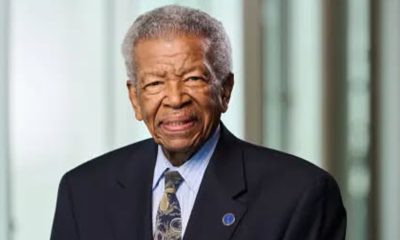#NNPA BlackPress
William “Bam” Sparks: Bridging the Digital Divide with Culture Wireless
THE ATLANTA VOICE — In recent years, internet connectivity has become necessary and essential to education, professional advancement, and daily life. However, certain communities, particularly those near Historically Black Colleges and Universities (HBCUs), are often excluded from reliable, high-speed internet access. Sparks, Culture Wireless’s CMO, has been actively working to address this issue. Based in Atlanta, Culture Wireless was founded during the COVID-19 pandemic to close the digital divide in underserved communities, particularly around Atlanta University Center and its surrounding areas.

By Noah Washington | The Atlanta Voice
“Why can’t we impact the infrastructure? Why can’t we own everything? Because at the end of the day, the moment we say something about it, that’s when it takes off,” said William “Bam” Sparks, 40, co-founder and Chief Marketing Officer of Culture Wireless, reflecting on Black culture’s innovation and potential.
In recent years, internet connectivity has become necessary and essential to education, professional advancement, and daily life. However, certain communities, particularly those near Historically Black Colleges and Universities (HBCUs), are often excluded from reliable, high-speed internet access. Sparks, Culture Wireless’s CMO, has been actively working to address this issue. Based in Atlanta, Culture Wireless was founded during the COVID-19 pandemic to close the digital divide in underserved communities, particularly around Atlanta University Center and its surrounding areas.
Sparks attended Albany State University to study chemical engineering before transferring to Georgia Tech to complete his degree. Upon graduation, a different path unfolded. During his time at Georgia Tech, he was introduced to the entertainment world by his cousin, Douglas Peterson, a friend of Atlanta rapper T.I.
When T.I. sought to establish a sports agency called Grand Hustle Sports, Sparks became one of the first people contacted. He pivoted to sports management, putting his chemical engineering background on hold to pursue this new career. His networking skills and business acumen quickly earned him a reputation, leading to success in the entertainment and sports management sectors.

Sparks (above) attended Albany State University to study chemical engineering before transferring to Georgia Tech to complete his degree. Photo by Noah Washington/The Atlanta Voice.
Sparks, a “Grady baby” from Collier Heights, first encountered the internet access issue at the AUC in 2020. There, he noticed a significant gap in connectivity between different Atlanta communities. “We went to the AUC to discuss E-Sports,” Sparks recalls. To his surprise, he found that while the area had high bandwidth capabilities, affordable internet options were lacking due to high costs from providers like AT&T and other ISPs. This inspired Sparks to create Culture Wireless, recognizing that existing networks often overlooked underserved communities. He observed that fiber internet costs were unaffordable for many residents. Thus, the idea for Culture Wireless emerged, aimed at providing affordable internet access for all.
In collaboration with various providers and local organizations, Sparks implemented a small data center and established a “mesh network” that connected nodes to provide internet access to the AUC area. This network proved essential after COVID-19, particularly as students struggled to complete assignments due to limited connectivity. The initial project served as a pilot for Culture Wireless’s broader mission to bridge the digital divide.
As a Black-owned Internet Service Provider (ISP), Culture Wireless faces the challenge of bringing affordable connectivity to underserved areas. Sparks highlights the Biden Administration’s Affordable Connectivity Program (ACP), which initially subsidized internet costs but was exhausted by early 2024. According to Sparks, his vision extends beyond Atlanta. “80% of HBCUs are in internet deserts,” he explained, referring to the limited infrastructure at many of these institutions. Culture Wireless aims to provide broadband access to HBCUs across the country, creating a foundation of connectivity that fosters educational and economic opportunities.
Despite their progress, Culture Wireless has faced obstacles. As venture capital (VC) funding for Black businesses reportedly declined by 60% in 2024, Culture Wireless felt the impact. “It’s a struggle. I feel like our issue has been finding people who invest in what we do,” Sparks said, referring to investors’ focus on trendy industries over internet equity. Nevertheless, Sparks believes that his team at Culture Wireless has the expertise and dedication to effect real change.
Together with his team—CEO Al Adjahoe, COO and co-founder Jerome Howard, Chief Brand Officer Marcus Stevens, and Chief Strategy Officer Pete Johnson—Sparks is confident in Culture Wireless’s potential to scale. Currently serving the AUC area and surrounding neighborhoods, including Vine City, The Bluff, and Clayton County, Sparks reflected, “After COVID, I saw that our kids didn’t have internet access. And I’m like, wow, this is crazy. Kids are literally going to the library to do their homework, but the fiber is right here. So why can’t I help provide it?”
Sparks is steadfast in his belief that internet access is a fundamental right. As he and his team press on, their mission centers on ensuring underserved populations are connected. “We, Black people—we are the culture, but we don’t own any of the infrastructure,” Sparks stated. Culture Wireless’s long-term goal is to equip the culture with the tools to keep innovating and pushing forward. “Why don’t we continue to change the narrative?”
To learn more about Culture Wireless, visit their website HERE.
#NNPA BlackPress
LIHEAP Funds Released After Weeks of Delay as States and the District Rush to Protect Households from the Cold
BLACKPRESSUSA NEWSWIRE — The federal government has released $3.6 billion in home heating assistance after a delay that left states preparing for the start of winter without the program’s annual funding.

By Stacy M. Brown
Black Press USA Senior National Correspondent
The federal government has released $3.6 billion in home heating assistance after a delay that left states preparing for the start of winter without the program’s annual funding. The Low-Income Home Energy Assistance Program, known as LIHEAP, helps eligible households pay heating and cooling bills. The release follows a shutdown that stretched 43 days and pushed agencies across the country to warn families of possible disruptions.
State officials in Minnesota, Kansas, New York, and Pennsylvania had already issued alerts that the delay could slow the processing of applications or force families to wait until December for help. In Pennsylvania, more than 300,000 households depend on the program each year. Minnesota officials noted that older adults, young children, and people with disabilities face the highest risk as temperatures fall.
The delay also raised concerns among advocates who track household debt tied to rising utility costs. National Energy Assistance Directors Association Executive Director Mark Wolfe said the funds were “essential and long overdue” and added that high arrearages and increased energy prices have strained families seeking help.
Some states faced additional pressure when other services were affected by the shutdown. According to data reviewed by national energy advocates, roughly 68 percent of LIHEAP households also receive nutrition assistance, and the freeze in multiple programs increased the financial burden on low-income residents. Wolfe said families were placed in “an even more precarious situation than usual” as the shutdown stretched into November.
In Maryland, lawmakers urged the Trump administration to release funds after the state recorded its first cold-related death of the season. The Maryland Department of Health reported that a man in his 30s was found outdoors in Frederick County when temperatures dropped. Last winter, the state documented 75 cold-related deaths, the highest number in five years. Rep Kweisi Mfume joined more than 100 House members calling for immediate federal action and said LIHEAP “is not a luxury” for the 100,000 Maryland households that rely on it. He added that seniors and veterans would be placed at risk if the program remained stalled.
Maryland Gov. Wes Moore used $10.1 million in state funds to keep benefits moving, but noted that states cannot routinely replace federal dollars. His administration said families that rely on medical equipment requiring electricity are particularly vulnerable.
The District of Columbia has already mapped out its FY26 LIHEAP structure in documents filed with the federal government. The District’s plan shows that heating assistance, cooling assistance, weatherization, and year-round crisis assistance operate from October 1 through September 30. The District allocates 50 percent of its LIHEAP funds to heating assistance, 10 percent to cooling, 13 percent to year-round crisis assistance, 15 percent to weatherization, and 10 percent to administrative costs. Two percent is used for services that help residents reduce energy needs, including education on reading utility bills and identifying energy waste.
The District’s plan lists a minimum LIHEAP benefit of $200 and a maximum of $1,800 for both heating and cooling assistance. Crisis benefits are provided separately and may reach up to $500 when needed to resolve an emergency. The plan states that a household is considered in crisis if it has been disconnected from energy service, if heating oil is at 5 percent or less of capacity, or if the household has at least $200 owed after the regular benefit is applied.
The District’s filing notes that LIHEAP staff conduct outreach through community meetings, senior housing sites, Advisory Neighborhood Commissions, social media, posters, and mass mailings. The plan confirms that LIHEAP applicants can apply in person, by mail, by email, or through a mobile-friendly online application and that physically disabled residents may request in-home visits.
As agencies nationwide begin distributing the newly released funds, states continue working through large volumes of applications. Wolfe said LIHEAP administrators “have been notified that the award letters have gone out and the states can begin to draw down the funds.”
#NNPA BlackPress
Seven Steps to Help Your Child Build Meaningful Connections
BLACKPRESSUSA NEWSWIRE — Swinging side by side with a friend on the playground. Sharing chalk over bright, colorful sidewalk drawings. Hiding behind a tree during a spirited game of hide-and-seek. These simple moments between children may seem small, but they matter more than we think

By Niyoka McCoy, Ed.D., Chief Learning Officer, Stride/K12
Swinging side by side with a friend on the playground. Sharing chalk over bright, colorful sidewalk drawings. Hiding behind a tree during a spirited game of hide-and-seek. These simple moments between children may seem small, but they matter more than we think: They lay the foundation for some of life’s most important skills.
Through everyday play, young children begin learning essential social and emotional skills like sharing, resolving conflicts, showing empathy, and managing their emotions. These social skills help shape emotional growth and set kids up for long-term success. Socialization in early childhood isn’t just a “nice-to-have”—it’s essential for development.
Yet today, many young children who haven’t yet started school aren’t getting enough consistent, meaningful interaction with peers. Research shows that there’s a decline in active free play and peer socialization when compared to previous generations.
There are many reasons for this. Children who are home with a parent during the day may spend most of their time with adults, limiting opportunities for peer play. Those in daycare or preschool may have restricted free play, and large classrooms can reduce supervision and social coaching. Some children live in rural areas, are homebound due to illness, have full schedules, or rely on screens to fill their playtime. And for some families, finding other families with young children to connect with isn’t easy.
While these challenges can feel significant, opportunities for connection still exist in every community. Families can take simple steps to help children build friendships, create a sense of belonging, and strengthen social skills. Here are some ideas to get started:
- Storytime sessions at libraries or local bookstores
- Community offerings such as parent-child workshops, art, music, gymnastics, swimming, or sports programs
- Weekly events at children’s museums, which may include art projects, music workshops, or science experiments
- Outdoor exploration, where kids can play with peers
- Local parenting groups that organize playdates and group activities
- Volunteer opportunities where children can participate, such as pet adoption events or packing meals at a food bank
- Classes for kids at local businesses, including hardware, grocery, or craft stores
Some of these community activities are free or low-cost and give kids the chance to build friendships and practice social skills. Parents can also model positive social behavior by interacting with other parents and encouraging their children to play with their peers.
These may seem like small moments of connection, but they can have a powerful impact. Every time your child shares a toy, plays make-believe with peers, or races a friend down the slide, they’re not just playing—they’re learning the skills that build confidence, empathy, and lasting friendships. And it’s good for you, too. Creating intentional opportunities for play also helps you strengthen your own network of parents who can support one another as your children grow together.
#NNPA BlackPress
Seven Steps to Help Your Child Build Meaningful Connections
BLACKPRESSUSA NEWSWIRE — Swinging side by side with a friend on the playground. Sharing chalk over bright, colorful sidewalk drawings. Hiding behind a tree during a spirited game of hide-and-seek. These simple moments between children may seem small, but they matter more than we think

By Niyoka McCoy, Ed.D., Chief Learning Officer, Stride/K12
Swinging side by side with a friend on the playground. Sharing chalk over bright, colorful sidewalk drawings. Hiding behind a tree during a spirited game of hide-and-seek. These simple moments between children may seem small, but they matter more than we think: They lay the foundation for some of life’s most important skills.
Through everyday play, young children begin learning essential social and emotional skills like sharing, resolving conflicts, showing empathy, and managing their emotions. These social skills help shape emotional growth and set kids up for long-term success. Socialization in early childhood isn’t just a “nice-to-have”—it’s essential for development.
Yet today, many young children who haven’t yet started school aren’t getting enough consistent, meaningful interaction with peers. Research shows that there’s a decline in active free play and peer socialization when compared to previous generations.
There are many reasons for this. Children who are home with a parent during the day may spend most of their time with adults, limiting opportunities for peer play. Those in daycare or preschool may have restricted free play, and large classrooms can reduce supervision and social coaching. Some children live in rural areas, are homebound due to illness, have full schedules, or rely on screens to fill their playtime. And for some families, finding other families with young children to connect with isn’t easy.
While these challenges can feel significant, opportunities for connection still exist in every community. Families can take simple steps to help children build friendships, create a sense of belonging, and strengthen social skills. Here are some ideas to get started:
- Storytime sessions at libraries or local bookstores
- Community offerings such as parent-child workshops, art, music, gymnastics, swimming, or sports programs
- Weekly events at children’s museums, which may include art projects, music workshops, or science experiments
- Outdoor exploration, where kids can play with peers
- Local parenting groups that organize playdates and group activities
- Volunteer opportunities where children can participate, such as pet adoption events or packing meals at a food bank
- Classes for kids at local businesses, including hardware, grocery, or craft stores
Some of these community activities are free or low-cost and give kids the chance to build friendships and practice social skills. Parents can also model positive social behavior by interacting with other parents and encouraging their children to play with their peers.
These may seem like small moments of connection, but they can have a powerful impact. Every time your child shares a toy, plays make-believe with peers, or races a friend down the slide, they’re not just playing—they’re learning the skills that build confidence, empathy, and lasting friendships. And it’s good for you, too. Creating intentional opportunities for play also helps you strengthen your own network of parents who can support one another as your children grow together.
-

 Activism3 weeks ago
Activism3 weeks agoOakland Post: Week of November 12 – 18, 2025
-

 Activism2 weeks ago
Activism2 weeks agoIN MEMORIAM: William ‘Bill’ Patterson, 94
-

 Activism3 weeks ago
Activism3 weeks agoHow Charles R. Drew University Navigated More Than $20 Million in Fed Cuts – Still Prioritizing Students and Community Health
-

 Bay Area3 weeks ago
Bay Area3 weeks agoNo Justice in the Justice System
-

 #NNPA BlackPress3 weeks ago
#NNPA BlackPress3 weeks agoThe Perfumed Hand of Hypocrisy: Trump Hosted Former Terror Suspect While America Condemns a Muslim Mayor
-

 #NNPA BlackPress2 weeks ago
#NNPA BlackPress2 weeks agoTrump’s Death Threat Rhetoric Sends Nation into Crisis
-

 #NNPA BlackPress4 weeks ago
#NNPA BlackPress4 weeks agoProtecting Pedophiles: The GOP’s Warped Crusade Against Its Own Lies
-

 #NNPA BlackPress3 weeks ago
#NNPA BlackPress3 weeks agoIn Major Win for Rep. Al Green, Texas Maps Blocked by Federal Judge





















































